Remembering “Star Wars” |
Read more
at in70mm.com The 70mm Newsletter |
||
| Written by: Michael Coate (Copyright 2003) | Date: May 25, 2003 | ||
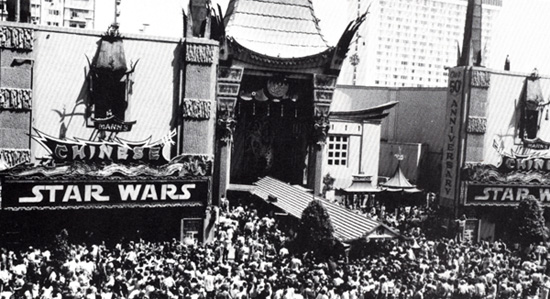 The date May 25, 1977 is
immortalized forever as the "birthdate" of one of the most
popular movies ever made: "Star Wars." Do you
remember the cities and theatres it opened in? The date May 25, 1977 is
immortalized forever as the "birthdate" of one of the most
popular movies ever made: "Star Wars." Do you
remember the cities and theatres it opened in?For over two and a half decades, enthusiastic fans have related tales of standing in long lines and have recalled in astounding detail their first impression of seeing the original movie in George Lucas' legendary "Star Wars" saga. Many moviegoers remember seeing the movie on opening day. Ah, but which opening day??? The passage of time has caused many people to forget that "Star Wars" (known today as "Star Wars: Episode IV - A New Hope") did not have the type of opening movies of today enjoy. That is, thousands of theatres across the country simultaneously opening a film. Rather, "Star Wars" opened initially in a mere 43 locations across the United States. Many sources over the years have cited 32 as the opening number of engagements, a number many trivia-minded fans may recognize. The number 32 is correct...well...sort of. The film indeed opened with 32 engagements on the 25th of May, a mid-week Wednesday opening, but what many may not realize is that there were additional bookings added over the ensuing two days which brought its opening weekend engagement total to 43. To say the film opened in 32 theatres is literally correct but does not tell the complete story. • Go to “Star Wars”: The North American 70mm Presentations • Go to “Star Wars - Special Edition”: The 70mm Presentations An immediate sensation, "Star Wars" (which TIME Magazine proclaimed "The Year's Best Movie" only five months into the year) accumulated incredible per-screen averages and broke numerous boxoffice and attendance records at the few locations lucky enough to have been playing the movie. The film industry was abuzz, and exhibitors everywhere couldn't wait to get their hands on a print. The film's distributor, 20th Century-Fox, had the lab cranking out prints as fast as they could as they accelerated their plans for a broad, nationwide release of the film. During the second week of release additional engagements were added in Los Angeles and Cincinnati to help accommodate high turn-away business in those markets. Still a week away from the start of the nationwide expansion, the third week saw two new engagements begin in Honolulu, Hawaii as well as an extra engagement added in the New York market. (The additional Los Angeles engagement, by the way, was booked into the Winnetka Drive-In and was presented in the newly-developed Cine-Fi car audio format.) The expanded release began with over 100 new engagements added throughout the U.S. during the week beginning June 17 (some runs began Wednesday the 15th) with additional engagements added each week (generally between 50 and 200) throughout the summer. At its peak in August and September "Star Wars" was playing in just over 1,000 theatres in the United States and Canada and was well on its way to surpassing "Jaws" (1975) and becoming the new all-time boxoffice champ. |
Further
in 70mm reading: “Star Wars”: The North American 70mm Presentations “The Empire Strikes Back”: The North American 70mm Engagements “Return of the Jedi”: The North American 70mm Engagements Films in 70mm Six-Track Dolby Stereo"70mm in Los Angeles "Star Wars" Presented in Dimension 150 70mm Blow-ups 70mm Engagements by Title 35mm to 70mm Engagements by Year |
||
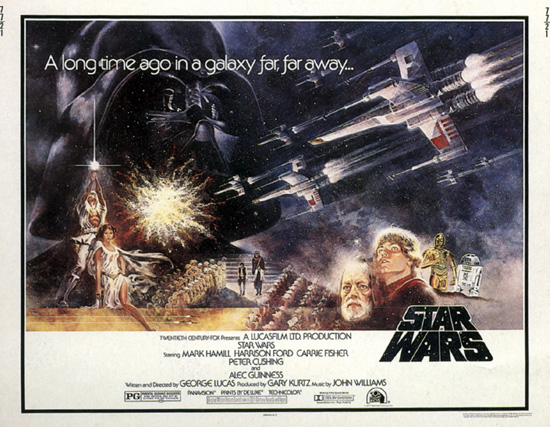 Although there were certainly fewer movie theatres in operation during the
1970s compared with today, a "wide" release of a mainstream,
non-specialized film at that time typically meant a few hundred
engagements. To illustrate just how low the number of theatres was that "Star
Wars" opened in, even by 1977 standards, here is for comparison a
sample of some of the highly-anticipated films from the spring and summer
of 1977 followed by the opening-week number of engagements for each: "A
Bridge Too Far" (400+), "The Deep" (800+), "Exorcist
II: The Heretic" (700+), "New York, New York"
(400+), "Orca" (700+), "The Other Side Of
Midnight" (500+), "Rollercoaster" (400+), "Smokey
And The Bandit" (300+), and "The Spy Who Loved Me"
(200+). Although there were certainly fewer movie theatres in operation during the
1970s compared with today, a "wide" release of a mainstream,
non-specialized film at that time typically meant a few hundred
engagements. To illustrate just how low the number of theatres was that "Star
Wars" opened in, even by 1977 standards, here is for comparison a
sample of some of the highly-anticipated films from the spring and summer
of 1977 followed by the opening-week number of engagements for each: "A
Bridge Too Far" (400+), "The Deep" (800+), "Exorcist
II: The Heretic" (700+), "New York, New York"
(400+), "Orca" (700+), "The Other Side Of
Midnight" (500+), "Rollercoaster" (400+), "Smokey
And The Bandit" (300+), and "The Spy Who Loved Me"
(200+).So why was "Star Wars" released to so few theatres initially when, in retrospect, the film seemed like such a sure-fire hit? In the 1997 book "Empire Building: The Remarkable Real Life Story Of Star Wars" by Garry Jenkins, former 20th Century-Fox executive Gareth Wigan offered an explanation: "'Star Wars' only opened in forty theaters because we could only get forty theaters to book it. That's the astonishing thing." "No one knew it was going to be a big hit," remembers Ben Burtt, who was responsible for "Special Dialogue & Sound Effects" on "Star Wars." "Nowadays, we take for granted that a big blockbuster will go out with thousands of prints, and open in May. But back then the summer special effects blockbuster did not exist." In Ted Edwards' "The Unauthorized Star Wars Compendium" (1999), Charles Lippincott, former Lucasfilm Ltd. Vice President for Advertising, Publicity, Promotion and Merchandising, mentioned that "If the film was redone today, on the basis of the way movies are released with a couple of thousand prints, it probably would have been unsuccessful. Theaters didn't want the movie. We were lucky to get thirty theaters to open it." Lippincott also remarked in that publication on the importance and prestige of getting booked in a major Hollywood theatre and the difficulty Fox faced in finding such a venue for "Star Wars." "At that time, Hollywood Boulevard was still very important for opening films. We only got on Hollywood Boulevard because the new Billy Friedkin film ("Sorcerer") wasn't ready yet. It was supposed to be ready by May 25 but wasn't, and we were given a month in the Chinese. It was the only way we got into Grauman's." For Peter Biskind's "Easy Riders, Raging Bulls: How The Sex-Drugs-And-Rock 'N' Roll Generation Saved Hollywood" (1998), "Sorcerer" film editor Bud Smith recalled his experience in seeing the coming attractions trailer he had cut for that film in front of "Star Wars" at the Chinese Theatre: "When our trailer faded to black, the curtains closed and opened again, and they kept opening and opening, and you started feeling this huge thing coming over your shoulder overwhelming you, and heard this noise, and you went right off into space. It made our film look like this little, amateurish piece of [expletive]. I told Billy [Friedkin], 'We're [expletive] being blown off the screen. You gotta go see this.'" To accommodate the opening of "Sorcerer" on 24 June, "Star Wars" was in fact moved to another theatre a couple of blocks away. But the space opera that at one time no one wanted would have the last laugh. As Friedkin's remake of "The Wages Of Fear" failed to live up to expectations while "Star Wars" continued to perform in stellar fashion, Lucas' epic moved back to the famous Chinese beginning August 3, where it stayed until June 1978. This marked the first time a film had returned to the Chinese for a second first-run engagement in the theatre's then fifty-year history. |
|||
 In contrast with the belief shared by many that "Star Wars"
was a tough sell to exhibitors, others feel that at least a few
people at 20th Century-Fox had a hunch the movie could be a big hit if
marketed carefully and given a platform-type "prestige" release,
specifically keeping the number of engagements limited to key markets
during the initial weeks of release. Other movies from 1977 given
successful prestige openings included "Julia," "The
Turning Point," and "Close Encounters Of The Third
Kind." Peter Myers, Vice President of Domestic
Distribution for Fox at the time, first saw "Star Wars" in a test
screening three months before scheduled release. He was very impressed,
and contemplated the best approach to marketing the film. "The
answer," Myers revealed to the Associated Press a few months
following the movie's opening, "was to position the picture in the
proper theaters and give it the proper presentation so the people
themselves could discover it and spread the word." In contrast with the belief shared by many that "Star Wars"
was a tough sell to exhibitors, others feel that at least a few
people at 20th Century-Fox had a hunch the movie could be a big hit if
marketed carefully and given a platform-type "prestige" release,
specifically keeping the number of engagements limited to key markets
during the initial weeks of release. Other movies from 1977 given
successful prestige openings included "Julia," "The
Turning Point," and "Close Encounters Of The Third
Kind." Peter Myers, Vice President of Domestic
Distribution for Fox at the time, first saw "Star Wars" in a test
screening three months before scheduled release. He was very impressed,
and contemplated the best approach to marketing the film. "The
answer," Myers revealed to the Associated Press a few months
following the movie's opening, "was to position the picture in the
proper theaters and give it the proper presentation so the people
themselves could discover it and spread the word."Why compile a list of original opening-week engagements for "Star Wars"? Hasn't such a list appeared in print, been discussed in conversation, or contained somewhere in the vastness of cyberspace? Well, let's put it this way...information pertaining to the original release of the film has all-too-frequently been misrepresented in published form and conversation over the years. This is an effort to separate fact from fiction, reality from myth, and to illustrate that memory is not a science. Also, in reading this article with a contemporary perspective, people may be surprised to find that the movie opened in so few theatres initially. There is also an historical "time capsule" factor in which fans might look over the list and be reminded of seeing the movie at one of the theatres. Movie buffs may find it nostalgic (or depressing) to scan the list and note the many theatres that no longer exist or have been multiplexed beyond recognition. Many of the theatres the film originally played in were huge 1,000+ seat, single-screen venues; movie palaces from a bygone era. And, since fans have debated, argued, and practically drawn lightsabers over the numerous versions that exist of the film, many will be interested to learn that the initial film prints prepared for "Star Wars" included a sound mix that a number of the prints distributed after the initial wave did not have. Another matter of interest (and controversy) is the presentation type audiences experienced in the opening weeks of release. Numerous books, trade publications, magazine and Internet articles, and fan recollections have over the years attributed "Star Wars" as having an exclusive opening in the "Dolby Stereo" process ("Dolby System" as it was then known), or having an exclusive "70mm Six-Track Dolby Stereo" opening with the 35mm versions appearing weeks later, or that the movie was the first ever to be released in Dolby Stereo. None were true! A few films were released in various forms of Dolby Stereo prior to "Star Wars" on a limited or test engagement basis such as "Tommy" (1975), "Nashville" (1975), "Lisztomania" (1975), "Logan's Run" (1976), and "A Star Is Born" (1976), though "Star Wars" was the first attempt at a wide release in the format. It appears that the distributor sought to book the film at the producers' urging in as many theatres as possible willing to install Dolby sound systems. The number of suitably-equipped venues, however, fell short of the total number of prints initially put into circulation. As for release prints in the deluxe (and expensive to produce) 70-millimeter format -- with its superior projection quality and exquisite six-track magnetic audio capability -- they were kept to a minimum. |
|||
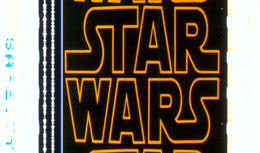 35mm
frame from "Star Wars". Note two stripes of optical SVA
soundtrack. 35mm
frame from "Star Wars". Note two stripes of optical SVA
soundtrack.Many technology-savvy and quality-conscious moviegoers may have a distinct recollection of attending a 70mm presentation. However, in looking over the list of original engagements included in this article some may be surprised to find that only eight 70mm engagements are noted, and that they were limited to theatres in the Los Angeles, New York, and San Francisco markets. Ah, but some of you are positive you saw a 70mm showing at a big, famous theatre in places such as Washington, D.C. (at the Uptown), or Dallas (Northpark), or Phoenix (Cine Capri), Chicago (Oakbrook), Detroit (Americana), Salt Lake City (Centre), Seattle (Cinema 150), Philadelphia (Mark I), Denver (Cooper; later in run at the Continental), or even Honolulu (Cinerama). Well, you did...but not during the month of May! Throughout the summer and fall of 1977 as "Star Wars" continued to perform beyond expectations Fox ordered several new 70mm prints, and many of the initial theatres, as well as others, were provided with a new large-format print. By the winter holidays over two dozen 70mm engagements could be found in the U.S. When people fondly recall the soundtrack experience of "Star Wars" -- the rumble of the Imperial Cruiser in the opening scene... the electronic squeaks and chirps of R2-D2... the hum of the lightsabers... the roar of the TIE Fighters... the Millennium Falcon's escape from the Mos Eisley spaceport and jump to hyperspace... the unforgettable John Williams music score... the climactic explosion of the Death Star... -- it is likely that one's memory is based on having attended a 70mm Six-Track Dolby Stereo presentation, with its qualitative superiority over conventional 35mm stereo and monaural presentations. While all things digital are commonplace today, back then "70mm" was the Rolls-Royce of the movies. |
|||
|
Variations in
the soundtrack presentations of "Star Wars" can be traced
to the multiple mixes that were prepared to accommodate the different
formats the movie would be released in: (1) 35mm two-track (four-channel) Dolby Stereo (2) 70mm Six-Track Dolby Stereo (3) 35mm Academy mono. (For international release, a fourth format would be available for exhibition: 35mm four-track magnetic stereo.) 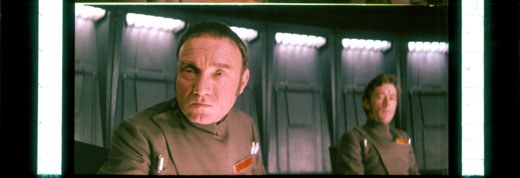 70mm
frame from "Star Wars". Proportionally the same size as the 35mm
frame above. Note amount of picture information. 70mm
frame from "Star Wars". Proportionally the same size as the 35mm
frame above. Note amount of picture information.Each version offered a different entertainment experience. The sound editing and re-recording team began by preparing a four-track master mix (Left-Center-Right-Surround), which would serve as the basis for both the 35mm and 70mm stereo versions. The master mix was dubbed into a matrix-encoded two-track Lt-Rt (Left total-Right total) printmaster for use on the 35mm Dolby Stereo prints. The same four-track master, with some enhancements, was also used to create the six-track version. In comparison to the 35mm Dolby Stereo version, the six-track soundtrack during playback offered discrete channels, greater clarity and dynamic range characteristics, and special low-frequency content (bass extension, or "baby boom"). After completing the multi-channel versions, the soundtrack crew created another English-language mix, a monaural mix, to be included on prints destined for theatres not equipped with a stereophonic sound system and for versions prepared for ancillary markets. Although the 35mm Dolby Stereo process was designed to be (and is) mono-compatible, at the time, those involved with the new technology were concerned about the effectiveness of mono playback from a stereo-encoded print for both technical and aesthetic reasons. For similar reasons, a decision was made not to create the mono master by means of dubbing the stereo master and "folding" the multiple tracks into one. Instead, a new dedicated mono mix was created from scratch. With each subsequent mix, the filmmakers seized opportunities to revise and enhance selected portions of the soundtrack where they had felt rushed or shortchanged creatively, wished different choices had been made for a given scene, or simply selected a different take of a given line of dialogue. Sound designer Ben Burtt recalls: "Because we were always trying to make the film better and better and fix things that were not right, there was some 'sweetening' done; things like different Stormtrooper or C-3PO lines, additional sound effects, or some different ADR." |
|||
|
At the time,
not knowing what the future would hold in terms of widespread adoption of
multi-channel sound not only in movie theatres but in homes as well, some
members of the production felt the mono mix represented the definitive
soundtrack of the movie (not in terms of a sonic experience but, rather,
in terms of audio content), and felt that the stereo version was a novelty
that select audiences would be treated to only during a brief theatrical
run. "George put a lot of effort in that mono mix," Burtt
remembers, "and he even said several times, 'Well, this is the real
mix. This is the definitive mix of the film.' He paid more attention to it
because he felt it was more important archivally." Knowing that multiple mixes were made that contained subtle yet detectable differences may help explain any conflicting or confusing memories of moviegoers who remember hearing a certain sound effect or line of dialogue in one presentation but not in another (a Stormtrooper calling out "Close the blast doors" while chasing Han Solo and Chewbacca through a Death Star corridor, for example). (Fans may be interested to know that "The Empire Strikes Back" was also released in separate versions that included numerous pictorial and audio differences...but that is another article.) Many theatres played the movie well into 1978. A number of the engagements exceeded one year! The Astor Plaza Theatre in New York City, for instance, played the film for 61 weeks, grossing nearly $4 million during that timeframe. Movies today barely play six weeks! The longest continuous run of "Star Wars" in North America was in Portland, Oregon. After Week 67 in September 1978, all engagements still running, save for Portland, were retired. (Portland's engagement was allowed to continue beyond the 67th and final week of release as a result of a boxoffice performance clause in its booking contract.) Okay, on with the main attraction! Click here for the complete and definitive list of original, first-week engagements of "Star Wars." |
|||
Trivia (U.S. and Canada release) |
|||
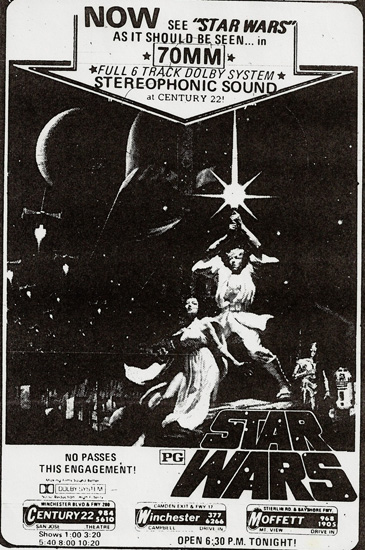 Number of engagements at widest point of distribution: 1,098
(original); 1,756* (1978 re-release) Number of engagements at widest point of distribution: 1,098
(original); 1,756* (1978 re-release)Number of theatres equipped with Dolby Stereo on film's opening week of release: 27 Opening day boxoffice gross (32 theatres): $254,809 Opening weekend boxoffice gross (four-day holiday weekend, 43 theatres): $2.1 million Opening weekend per-screen average: $48,837 Top-grossing movie in North America during opening weekend (May 27-30): "Smokey And The Bandit" ($2.7 million, 386 engagements) Number of days in release when gross surpassed $100 million: 81 Total boxoffice gross during summer season (Memorial Day - Labor Day): $133.7 million Total domestic boxoffice gross original run: $265.1 million** Place on all-time domestic boxoffice gross and film rental lists at end of original run: 1 Longest-running engagement: 76 weeks, Westgate (Portland) Highest-grossing engagement: Astor Plaza (New York) Highest per-screen average: Coronet (San Francisco) Current domestic boxoffice gross (including all re-releases): $461 million Current place on all-time domestic boxoffice gross list: 2 *Included here because there was never a point in time where all of the prints from the original release had been withdrawn. The "original" release "ended" on July 20, 1978 and the "re-release" began the following day, July 21. This was in effect an "extended first-run" but is often referred to as a "general release" and a "re-release," though not a re-release in the conventional sense. (The film had official re-releases in North America in 1979, 1981, 1982, and 1997.) **Includes 60-week original run (05/25/77 - 07/20/78) + seven-week extended first-run/general release/re-release (07/21/78 - 09/07/78) + nine-week extended Portland run (09/08/78 - 11/07/78). |
|||
Additional Information & Statistics (U.S. and Canada release) |
|||
|
Release schedule/Total number of engagements during weekend beginning: May 27: 43 June 03: 2 (45) June 10: 3 (48) June 17: 109 (157) June 24: 203 (360) July 01: 136 (496) July 08: 81 (577) July 15: 51 (628) July 22: 183 (811) July 29: 145 (956) Aug 05: 88 (1,044) |
|||
Newspaper sources (various 1977-78 movie advertisements) |
|||
|
|||
Bibliography & Sources (general research and specific references) |
|||
|
|||
Special Thanks |
|||
|
Academy of Motion Picture Arts And Sciences Bill Brinkman Ben Burtt Jim Cartwright Dolby Laboratories, Inc. Derek Gee Nicholas Grieco Modest Iwasiw Jeffry Johnson William Kallay Steve Kraus Bill Kretzel Roberto Landazuri Alan & Shanna Lemke Mark Lensenmayer Paul Linfesty Tricia Littrell Adam Martin Jim Millick Jim Perry John Pytlak Mike Schindler Grant Smith Darryl Spicer and, a number of helpful librarians from across the U.S. All images copyright Twentieth Century-Fox and Lucasfilm Ltd. |
|||
|
Go: back
- top - back issues
- news index Updated 22-01-25 |
|
